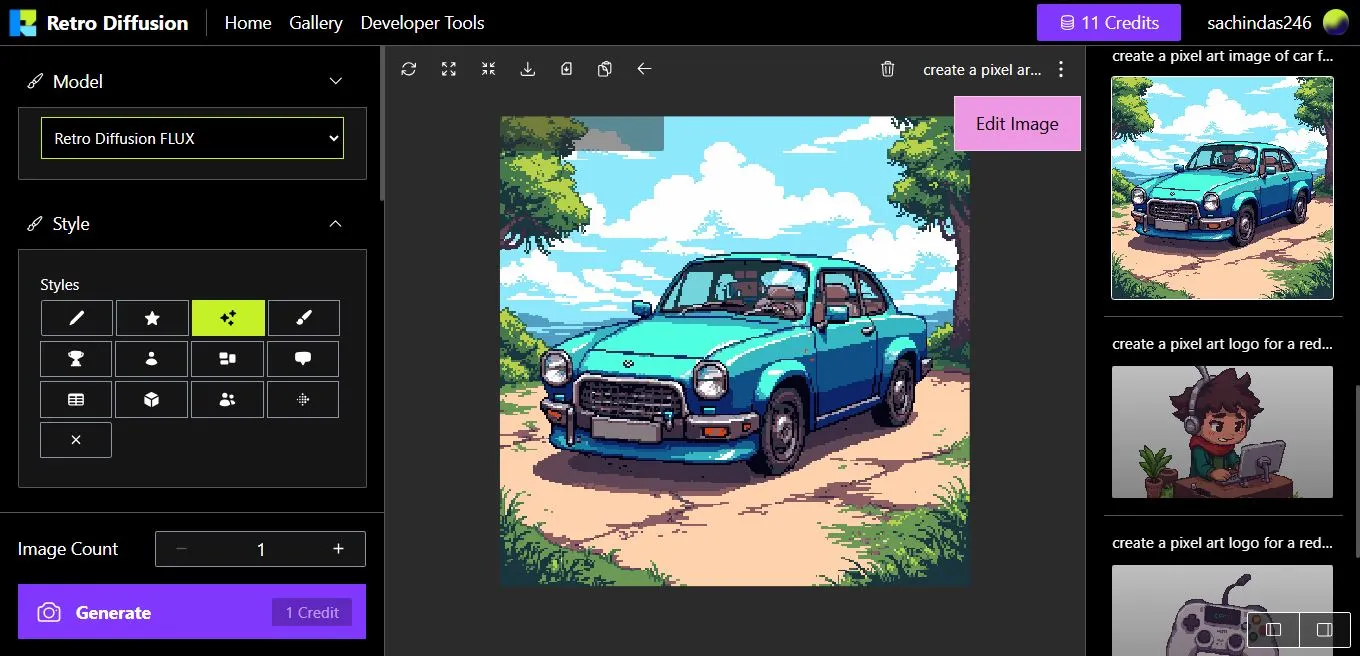Review on Retro Diffusion
Retro-Diffusion.ai - Best way to create pixel art using AI?
As someone deeply rooted in game development, I've always held a special appreciation for pixel art. While my own skills in crafting it were modest, the artistry and meticulous effort involved never failed to fascinate me.

In this blog we are going to review Retro-Diffusion.ai, a tool that can generate pixel art using AI.
When the AI revolution began, one of my very first searches was for a tool that could genuinely generate good pixel art. Many early attempts by various AI models fell short, producing results that lacked the charm and precision of human-created sprites. So now after testing Retro-Diffusion.ai, I really liked it.
Getting Started
The website itself is clean and immediately communicates the tool's purpose. After a straightforward registration process, you gain access to the core application.
Here, you're presented with two distinct modes for creation:
- Retro Diffusion FLUX: For generating static pixel art images.
- Retro Diffusion Animations: For creating animated pixel art sequences.
Each mode serves a different purpose and utilizes credits differently, offering flexibility depending on your project's needs.
Diving Deep: Retro Diffusion FLUX (Static Images)
 This is likely where most users will start. FLUX is designed for creating single, static pixel art images. The interface provides a robust set of options:
This is likely where most users will start. FLUX is designed for creating single, static pixel art images. The interface provides a robust set of options:
- Prompting: Describe the image you want to create.
- Style Selection: Choose from various predefined pixel art styles.
- Prompt Enhancement: An option to potentially improve your text prompt for better results.
- Background Removal: A handy feature to isolate your subject.
- Technical Settings: Control width, height, tiling (for seamless patterns), and seed (for reproducible results).
- Input Image: Provide an existing image as a reference or base.
- Custom Palette: Upload your own color palette to enforce specific constraints.
Compared to other AI tools I'd tried for pixel art, the results from Retro Diffusion FLUX are crazy good. It manages to capture the essence of pixel art in a way others couldn't, producing genuinely usable assets that feel significantly closer to handcrafted quality.
- Cost: Generating a static image in FLUX mode typically costs just 1 credit.
Bringing Pixels to Life: Retro Diffusion Animations

For game developers or anyone needing animated sprites, the Animations mode is a potential game-changer. It offers many similar options to FLUX (prompt, dimensions, tiling, input image, palette) but adds the crucial ability to generate animated sequences. You can also select different variants for the animation style or motion. While animation is inherently more complex, the results here are also impressive, especially when you consider the time investment required for handcrafting pixel animations frame by frame.
- Cost: Generating an animation costs 10 credits.
Performance, Pricing, and Peace of Mind
-
Speed: One of the immediate advantages I noticed was the generation speed. Retro-Diffusion.ai delivers results remarkably fast compared to many general-purpose AI image models.
-
Pricing & Trial: The pricing structure is very reasonable and transparent. Crucially, they offer a generous free trial with 50 credits. This is more than enough to thoroughly test both static image generation and animation features to see if it fits your workflow.
-
Buying Credits: After the free trial, you can purchase credits in bulk:
-
$5: 375 credits (~75 credits per dollar)
-
$10: 800 credits (~80 credits per dollar)
-
$25: 2250 credits (~90 credits per dollar)
-
$50: 5500 credits (~110 credits per dollar)
Ethical Considerations:
A major concern with many AI models is the source of their training data. I was pleased to learn that the creator of Retro-Diffusion.ai is an experienced pixel artist themselves. The model was primarily trained on their own extensive body of work, supplemented by art from other creators who explicitly gave permission for their work to be used. This ethical approach, avoiding unauthorized scraping, is a significant plus point.
Bonus:
Aseprite Plugin: For serious pixel artists, the integration with existing workflows is key. Retro-Diffusion.ai offers an official plugin for Aseprite, the beloved pixel art editor. This is a fantastic addition that streamlines the process of generating and refining AI pixel art within a familiar environment.
Conclusion: Is Retro-Diffusion.ai the Best AI for Pixel Art?
Based on my experience, Retro-Diffusion.ai stands out significantly in the current landscape of AI art generators. It delivers high-quality results specifically tailored for pixel art, generates them quickly, operates on an ethical training data foundation, and offers generous, affordable pricing.
The Aseprite plugin is the cherry on top for dedicated artists.While AI may not perfectly replicate the unique touch of a master pixel artist yet, Retro-Diffusion.ai comes impressively close and provides an incredibly powerful tool for rapid prototyping, asset generation, and creative exploration.
I highly recommend Retro-Diffusion.ai to game developers, artists, hobbyists, or anyone looking to create compelling pixel art using the power of AI. The free trial makes it easy to see the magic for yourself.
